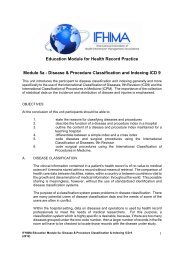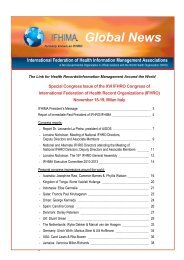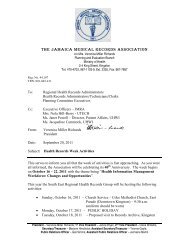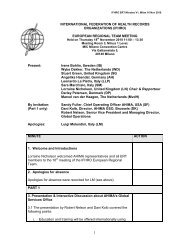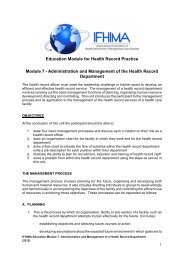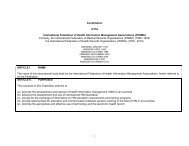Learning Packages for Medical Record Practice - ifhima
Learning Packages for Medical Record Practice - ifhima
Learning Packages for Medical Record Practice - ifhima
You also want an ePaper? Increase the reach of your titles
YUMPU automatically turns print PDFs into web optimized ePapers that Google loves.
the health in<strong>for</strong>mation professional/health record administrator to establish<br />
systems and procedures to ensure the efficient production of health records <strong>for</strong><br />
patient care, medico-legal purposes, statistics, teaching and research.<br />
The health record department is judged on the efficient service it provides to the<br />
rest of the hospital or clinic. That is, health records must be readily available when<br />
required <strong>for</strong> patient care. Departmental efficiency and record control are there<strong>for</strong>e<br />
two of the most important things to consider in the management of the health<br />
record services.<br />
1. Alphabetical filing<br />
When no health record number is assigned, and the patient's name is the<br />
only identifier, then alphabetical filing is the only possible method to use.<br />
Filing is by patient surname first, then given name, and finally middle name<br />
or initial. <strong>Record</strong>s of patients with exactly the same name should then be<br />
filed according to their date of birth date.<br />
This type of filing is time consuming and the risk of errors (change of name,<br />
misspelling) is extremely high. Moreover, there is no way to control the use<br />
of the file area as it is not possible to know be<strong>for</strong>ehand where the next new<br />
record will be filed. Since names are not equally distributed, it is extremely<br />
difficult to avoid congestion areas and back shifting to open new file space.<br />
Alphabetical filing is not recommended, and is only useful <strong>for</strong> facilities with a<br />
limited patient population and a small files area, with a very low patient<br />
turnover rate.<br />
2. Numerical filing systems<br />
If a numerical record identification system is used, then a numerical filing<br />
system is used. There are two main systems of filing records numerically:<br />
straight numeric and terminal digit.<br />
a.<br />
Straight numerical filing<br />
In this system, health records are filed in straight numeric sequence as<br />
follows:<br />
8984 108264<br />
8985 108265<br />
8986 108266<br />
8990 108267<br />
This filing method reflects exactly the chronological order of the creation<br />
of records. Straight numeric filing is typically used when serial health<br />
record numbers are assigned, however, a unit health record number may<br />
also be filed in straight numerical order.<br />
IFHIMA Education Module 3: <strong>Record</strong> Identification Systems, Filing and Retention of Health <strong>Record</strong>s<br />
(2012)<br />
11



